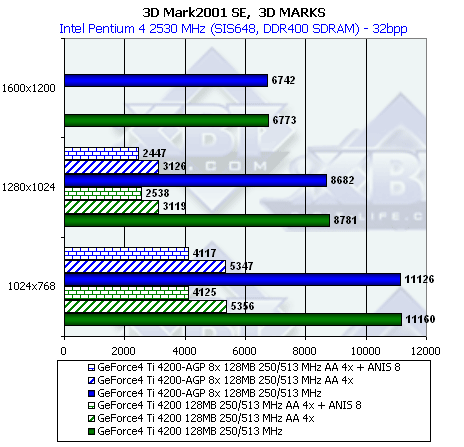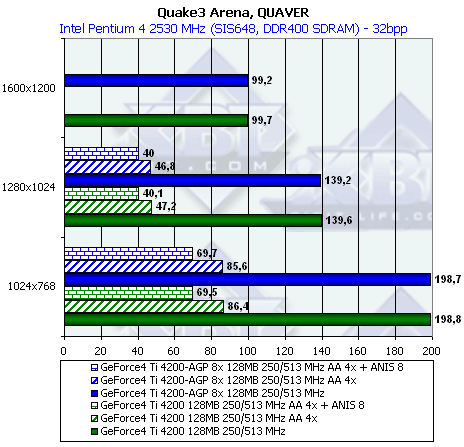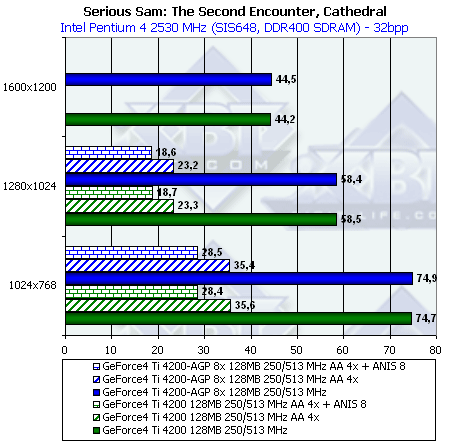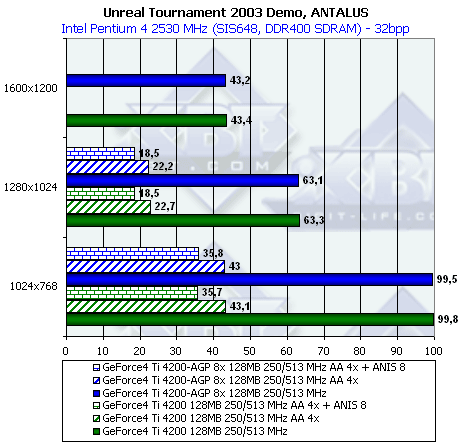NVIDIA GeForce4 Ti 4200 with AGP8x (NV28) and
GeForce4 MX 440 with AGP8x (NV18)
|

Contents
-
Eight
x's - what's new?
-
Peculiarities
of NV28 and NV18 based video cards
-
Test
system configuration and driver settings
-
Test
results: briefly on
2D
-
Test
results: 3DMark2001
SE game tests
-
Test
results: Quake3
ARENA
-
Test
results: Serious
Sam: The Second Encounter
-
Test
results: Return
to Castle Wolfenstein
-
Test
results: Code
Creatures DEMO
-
Test
results: Comanche4
DEMO
-
Test
results: Unreal
Tournament 2003 DEMO
-
Test
results: AquaMark
-
Test
results: RightMark
3D
-
Conclusion
Eight x's - what's new?
We know quite well that AGP is a bottleneck in a system which controls
data processing in image displaying, namely: CPU bus, memory, north bridge,
accelerator, and accelerator's memory. Well, it's one more step towards
the perfection. Let's sum up the differences and new features of the AGP
3.0 standard, also known as AGP 8x:
-
Doubled throughput - 2.1 GB/s, the effective clock speed is equal to 533
MHz:
| |
AGP 4X |
AGP 8X |
| Bytes per transfer |
4 (32 bits) |
4 (32 bits) |
| Clock rate |
266.67MHz |
533.33MHz |
| Bus bandwidth |
1.1GB/sec. |
2.1GB/sec. |
-
The isochronous data transfer (i.e. continuous stream transfer with a guaranteed
latency) got new capabilities which let the accelerator know that required
parameters will be delivered in time - it makes possible to avoid null
cycles.
-
The bus is entirely (forward and backward) compatible with cards of the
previous version (AGP 2.0) and can work in 2x and 4x modes in the 2.0 standard
and in 4x and 8x modes in the extended 3.0 standard. So, new cards which
comply with the AGP 8x specification will be compatible with motherboards
with AGP 2x, 4x and 8x, and new AGP 8x boards will support cards with 2x
and 4x provided that they comply with the AGP 2.0 or 3.0 specification.
As we know, there are some compatibility problems with earlier implementation
of the AGP 8x (SIS 468, R300 etc.).
-
Optimizations for efficient AGP texturing are promised.
-
Some rare and unpopular capabilities of the 2.0 will be removed (they can
be deleted without losing compatibility).
Well, the paper looks magnificant. But no applications can actually get
a significant gain with the AGP 8x (except some specific synthetic tests).
I hope such applications will appear soon, but at present AGP 8x is not
a weighty argument for a buyer. Well, if one has to pay a lot of money
over to get 8x, then it doesn't make sense to get such a card, especially
because current bus realizations have some compatibility problems with
graphics solutions, for example, from ATI. It's clear that only with the
reference implementation of the AGP 3.0 in one of the Intel's chipsets
the problems of interpretation of the standard and of compatibility won't
be so vital anymore.
It's interesting that the modern accelerators don't use effectively
the AGP bus - it's still far even from the theoretical limit of the AGP
4x; only NVIDIA is a step closer to it. However, it is possible that the
AGP conception or the way it's realized in the chipsets can also be blamed.
I hope the Intel's AGP 8x and NV30 solutions will pump graphics data through
the bus much faster.
Without further ado let's turn to the cards we are testing today.
Cards
The cards have AGP x2/x4/x8 interface, 128 MB DDR SDRAM (8 chips
on both PCB sides) on the GeForce4 Ti 4200 with AGP8x (NV28), and 64 MB
DDR SDRAM (4 chips on the front PCB side) on the GeForce4
MX 440 with AGP8x (NV18) .
| NVIDIA GeForce4 Ti 4200 with AGP8x (NV28) |

|

|
| NVIDIA GeForce4 MX 440 with AGP8x (NV18) |

|

|
| NVIDIA GeForce4 Ti 4200 with AGP8x (NV28) |
| Samsung memory modules, 4ns access time. The highest frequency is 250
(500) MHz, but by default the memory runs at 256 (513) MHz. The chip is
clocked at 250 MHz |

|
| NVIDIA GeForce4 MX 440 with AGP8x (NV18) |
| Samsung (BGA) memory modules, 3.6ns access time. The highest frequency
is 275 (550) MHz, but the memory runs at 256 (513) MHz. The chip is clocked
at 275 MHz |

|
While the NV28 (in Ti 4200) still comes with ordinary memory modules,
the NV18 in MX 440 is a different case. Memory chips in the BGA package
could be seen only on the MX 460 cards, and the new MX 440 with AGP8x will
have them as well. These chips have 3.6ns access time which is usually
required for the memory running at 275 MHz, but here the memory is clocked
at 256 MHz (a sweet pie for overclockers :-).
| NVIDIA GeForce4 Ti 4200 with AGP8x (NV28) |

|

|
| NVIDIA GeForce4 Ti 4200 (NV25) |

|

|
The design of the NV28 is identical to the reference one for the Ti
4200. The only difference is a cooler mounted on the chip:

Such cooler is often installed on the reference cards of the GeForce3 line.
Remove it and you will see the GPU:

The photo above clearly shows that the AGP 8x is supported.
Now look attentively at the NV18.
| NVIDIA GeForce4 MX 440 with AGP8x (NV18) |

|

|
| NVIDIA GeForce4 MX 440 (NV17) |

|

|
Here there are more differences: the memory comes in the BGA package,
all memory chips are on the front side and the card supports two heads,
i.e. nView, so that an image can be seen on two monitors and/or TV. Besides,
the new MX 440 works at a higher frequencies than its predecessor
(memory clock speed).
Although the chip's frequency is 5MHz higher (275 against 270 MHz),
NVIDIA recommends using a cooler without a fan:

If you remove the heatsink you will see that the chip is marked as 8x:

Test system and drivers
Testbeds:
-
Pentium 4 based computer (Socket 478):
-
Intel Pentium 4 2530;
-
ASUS P4S8X (SIS 648);
-
512 MB DDR SDRAM PC3200;
-
Seagate Barracuda IV 40GB;
-
Windows XP Professional Service Pack 1.
The test system was coupled with ViewSonic P810 (21") and
ViewSonic
P817 (21") monitors.
In the tests we used the NVIDIA's drivers 40.41 (with a separately received
altered INF file).
The following cards are taken for comparison:
-
Albatron GeForce4 Ti 4200 (250/256 (513) MHz, 128 MB, driver 40.41);
-
Leadtek WinFast A170T (GeForce4 MX 440, 270/200 (400) MHz, 64 MB, driver
40.41);
-
Hercules 3D Prophet 9000 Pro (RADEON 9000 Pro, 275/275 (550) MHz, 64 MB,
driver 6.166).
Driver settings
In the control panel of the drivers we switched off VSync for Direct3D
and OpenGL, as well as AA. In the games' settings we disabled texture compression
(when possible). On the SIS 648 based system we used AGP drivers 1.11.
Both NV28 and NV18 cards worked in the AGP 8x mode, which was also demonstrated
by the PowerStrip and RivaTuner. All the other cards used AGP4x.
Test results
2D graphics
Coupled with the ViewSonic P817 monitor and BNC Bargo cable the
tested samples performed brilliantly at the following resolutions and frequencies:
| NVIDIA GeForce4 Ti 4200 with AGP8x (NV28) |
1600x1200x85Hz, 1280x1024x100Hz, 1024x768x120Hz |
| NVIDIA GeForce4 MX 440 with AGP8x (NV18) |
1600x1200x75Hz, 1280x1024x100Hz, 1024x768x120Hz |
3D graphics, 3DMark2001 - game tests
3DMark2001, 3DMARKS


Although we tested the cards on the GeForce4 Ti 4200 with AGP8x and Ti
4200 under different loads (with AA and anisotropic filtering), they got
identical results. It means that for 128MB cards the increased throughput
of AGP doesn't make much sense. It also concerns the NV18. You will know
why a bit later when you see volumes of textures used on one or another
3DMark2001 test.
The new MX 440 which comes with a faster memory gets a decent performance
boost, though the RADEON 9000 Pro is still too far ahead thanks to its
mechanisms of operation with shaders (it means that the Game4 brings in
good scores).
3DMark2001, Game1 Low details


Test characteristics:
-
Rendered triangles per frame (min/avg/max): 19773/33753/143422
-
Rendered textures per frame with 16 bit textures (min/avg/max): 7.5/8.8/16.5
MB
-
Rendered textures per frame with 32 bit textures (min/avg/max): 15.1/17.7/30.3
MB
-
Rendered textures per frame with texture compression (min/avg/max): 10.7/12.2/21.0
MB
Neither for the NV28 nor for the NV18 the AGP8x renders any help. Look
at the texture volume - 30 MB maximum, that is why 64MB on the card is
enough to put all the textures into the local memory.
3DMark2001, Game2 Low details


Test characteristics:
-
Rendered triangles per frame (min/avg/max): 46159/51440/147828
-
Rendered textures per frame with 16 bit textures (min/avg/max): 8.0/8.8/10.1
MB
-
Rendered textures per frame with 32 bit textures (min/avg/max): 15.6/17.2/19.8
MB
-
Rendered textures per frame with texture compression (min/avg/max): 9.3/10.9/13.5
MB
Well, the only thing that should be noted is that the RADEON 9000 Pro outscores
even the GeForce4 MX 440 with AGP8x which runs at the higher frequency.
3DMark2001, Game3 Low details


Test characteristics:
-
Rendered triangles per frame (min/avg/max): 16681/21746/39890
-
Rendered textures per frame with 16 bit textures (min/avg/max): 2.8/4.1/4.7
MB
-
Rendered textures per frame with 32 bit textures (min/avg/max): 5.7/8.2/9.4
MB
-
Rendered textures per frame with texture compression (min/avg/max): 5.0/7.2/8.4
MB
Well, the AGP's 8x mode is not needed at all because of such amount of
textures.
3DMark2001, Game4

Test characteristics:
-
Rendered triangles per frame (min/avg/max): 55601/81714/180938
-
Rendered textures per frame with 16 bit textures (min/avg/max): 14.9/17.4/20.7
MB
-
Rendered textures per frame with 32 bit textures (min/avg/max): 28.4/33.5/40.0
MB
-
Rendered textures per frame with texture compression (min/avg/max): 28.4/33.5/40.0
MB
This test could give a chance to the NV18 card to show capabilities of
the higher throughput of the AGP 8x, but unfortunately, this card lacks
for pixel shaders (in contrast to the RADEON 9000 which has a similar price).
As for the NV28, its 128 MB is a big hanger which can easily house 40 MB
of textures.
So, if the new GeForce4 MX 440 with AGP8x sell at the prices the MX
440 is available today, they will definitely be popular with users, because
their speed has grown considerably but at the expense of the faster memory,
not thanks to the AGP 8x.
The 3DMark2001, like all modern games, mostly deals with video card's
memory, not with pumping data through the AGP, and as we found out the
video memory size is quite enough for such tests.
3D graphics, game tests
For the performance estimation we used:
-
Return to Castle Wolfenstein (MultiPlayer) (id Software/Activision) - OpenGL,
multitexturing, Checkpoint-demo,
test settings - maximum, S3TC OFF, the configurations can be downloaded
from here
-
Serious Sam: The Second Encounter v.1.05 (Croteam/GodGames) - OpenGL, multitexturing,
Grand Cathedral demo, test settings: quality, S3TC OFF
-
Quake3 Arena v.1.17 (id Software/Activision) - OpenGL, multitexturing,
Quaver,
test settings - maximum: detailing level - High, texture detailing
level - #4, S3TC OFF, smoothness
of curves is much increased through variables r_subdivisions "1"
and r_lodCurveError "30000" (at default r_lodCurveError is
250 !), the configurations can be downloaded from
here
-
Comanche4 Benchmark Demo (NovaLogic) - Direct3D, Shaders, Hardware T&L,
Dot3, cube texturing, highest quality
-
Unreal Tournament 2003 Demo (+Patch 1080) (Digital Extreme/Epic Games)
- Direct3D, Vertex Shaders, Hardware T&L, Dot3, cube texturing, default
quality, FlyBy CITADEL and FlyBy ANTALUS tests
-
Code Creatures Benchmark Pro (CodeCult) test demonstrates operation of
cards in the DirectX 8.1, Shaders, HW T&L.
-
AquaMark (Massive Development) test demonstrates operation of cards in
the DirectX 8.1, Shaders, HW T&L.
-
RightMark Video Analyzer v.0.4 (Philip
Gerasimov) - DirectX 8.1, Dot3, cube texturing, shadow buffers, vertex
and pixel shaders (1.1, 1.4).
Quake3 Arena, Quaver


The GeForce4 MX 440 with AGP8x aces everyone in this test (RADEON 9000
Pro is hopelessly behind).
Serious Sam: The Second Encounter, Grand Cathedral
The screenshots of settings of this game can be found in this
review.


At last, the AGP is enabled to a much greater extent for the MX 440, and
its 8x mode is now able to bring higher scores. But in case of the NV28
the 128MB memory remains very huge even for this game. Moreover, the RADEON
9000 Pro easily outdrives both the NV18 and MX 440. The programmers from
ATI did their best to improve operation of the drivers, in particular,
for this benchmark.
Return to Castle Wolfenstein (Multiplayer), Checkpoint


The games under the OpenGL (except Quake3) use the AGP to a more degree,
and in this case we can see that the NV18 wins the battle with the MX 440,
especially in 1600x1200. Like in the Quake3, the RADEON 9000 Pro loses
to its competitors, though here it looks better than in that benchmark.
Code Creatures

No comments.
Comanche4 DEMO


It's interesting that this very processor-dependent test doesn't neglect
higher bandwidth of the AGP, and the NV18 boost is noticeable. As for the
NV28, I don't see any difference between the NV28 and NV25.
The RADEON 9000 Pro takes the palm again; it falls behind the NV18 only
in 1600x1200.
Unreal Tournament 2003 DEMO
CITADEL


The NV18 unexpectedly falls behind the MX 440, probably because of the
drivers. Anyway, the RADEON 9000 Pro remains a champion among mid-level
cards. As for the NV28, there is no difference between the AGP4x and AGP8x
cards.
ANTALUS


The situation is similar but for the fact that the MX 440 is able to beat
the RADEON 9000 Pro.
AquaMark


Well, this is the only case when the NV28 outdoes the Ti 4200 in 1024x768;
the situation is in general the same.
Although the NV18 managed to outrun the MX 440, the RADEON 9000 Pro
comes with more perfect scores (shaders...) .
RightMark 3D

Although this test is very difficult (it was developed to estimate operability
of modern accelerators with DX8.1 enabled and the speed of operation),
128MB of the GeForce4 Ti 4200 with AGP8x is more than enough, that is why
we notice no difference from the Ti 4200.
Like in the 3DMark2001, for the 128MB cards the AGP8x support means
nothing. There are no games which would benefit from a higher bandwidth
of the AGP.
The NV18 has received some advantages, but they are not weighty enough.
A stronger argument for the MX 440 is faster memory which provides a performance
gain as compared with the former MX 440. But anyway, the ATI's RADEON 9000
Pro is still leading.
Conclusion
So,
-
The less the memory of the video card, the less the effect of the AGP8x.
You shouldn't expect any performance increase from the 128MB Ti 4200-8x.
But you should account for the fact that NVIDIA has released the Ti 4200
with AGP8x bundled with 4ns memory working at 256 (513) MHz. As you remember,
all 128MB cards based on the Ti 4200 were initially clocked at 222 (444)
MHz (memory). The Californian company urges the manufacturers to increase
memory frequencies on 128MB cards. We didn't compare Ti 4200-8x (256 MHz
memory) with old Ti 4200 with the memory working at 222 MHz because it's
not correct. Anyway, we have carried out an objective comparison of two
cards running at equal frequencies.
-
In case of the NV18, we compared the MX 440-8x on former 270/200 MHz with
the MX 440, as well as revealed performance of the MX 440 with AGP8x at
its rated frequencies of 275/256 MHz. Given to the fact that NVIDIA has
a strong rival in this market sector, it was very interesting for us to
find out whether the new NV18 could fight against the ATI RADEON 9000 Pro.
Well, the NV18 yields to the latter quite often. Moreover, it's deprived
of pixel shaders, EMBM, and a higher-level anisotropic filtering.
If the new MX 440 with AGP8x are going to sell at the prices of former
MX 440, the NV18 stands a chance to become popular. Otherwise, it would
be a real problem to fight against the RADEON 9000 Pro which is gradually
falling down in price.
The NV28 must certainly be comparable in price with the current Ti 4200.
I think that advantages of the AGP8x won't bring tangible benefit as compared
with the AGP4x.
BUT! If, even next year, games start using texture volumes over 100-150
MB for a scene or the increased AGP throughput is used more intensively,
the current NV18/NV28 will get a second wind and be able to lift up their
performance level (by that time the Ti 4200 will probably become a low-end
solution).
Write a comment below. No registration needed!
|
|
 |
|
|
|






























